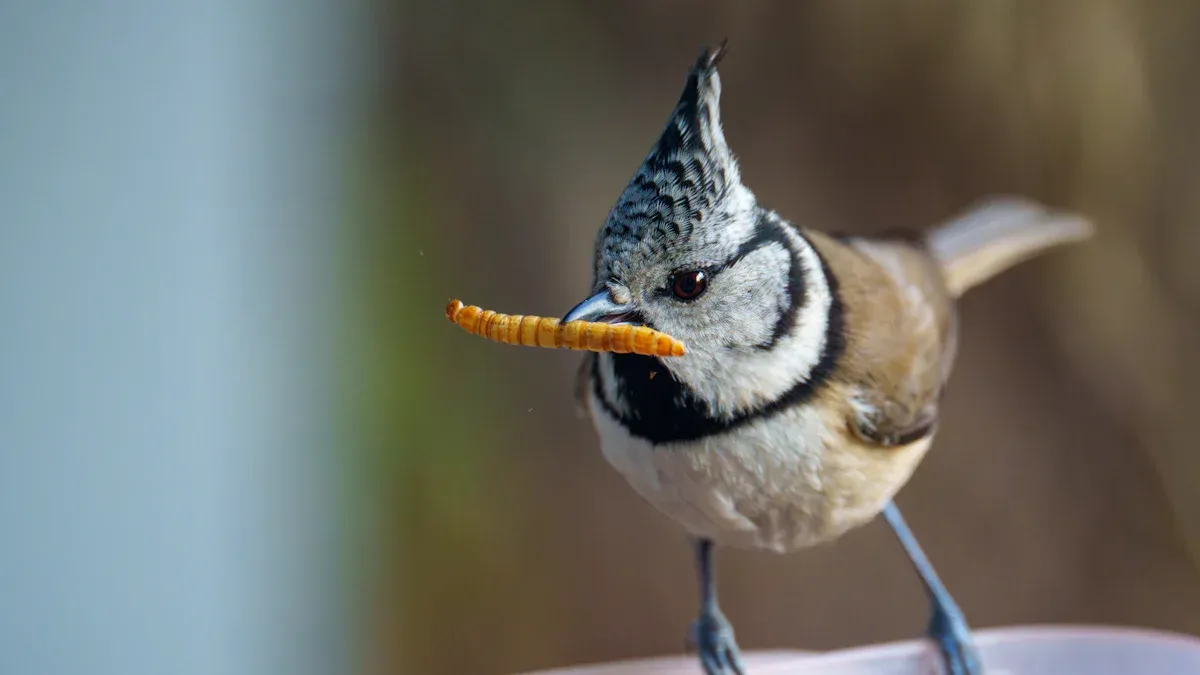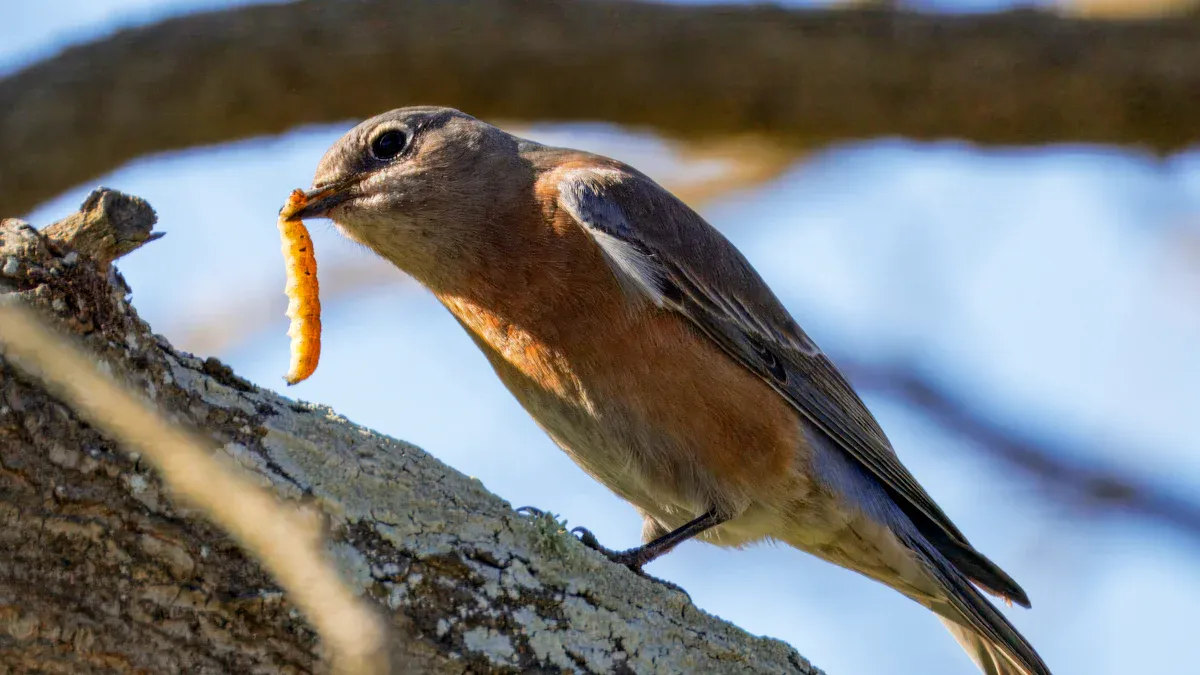
Birdwatchers often rave about the benefits of dried mealworms bird. These tiny treats pack a punch when it comes to nutrition. Containing 53% protein and 28% lipids, they’re a powerhouse for feathered friends. One birdwatcher shared how using three small bowl feeders filled with mealworms attracted Eastern Bluebirds and even warblers. Convenience meets results!
Key Takeaways
- Dried mealworms are very healthy for birds. They have 53% protein and important nutrients that help birds stay strong, active, and grow feathers.
- They last a long time and are easy to store. This makes them a simple option for birdwatchers to feed birds without worrying about them going bad.
- Feeding birds dried mealworms brings many types of birds. It makes birdwatching more fun and helps people feel closer to nature.
Nutritional Benefits of Dried Mealworms Bird
High Protein Content for Bird Health
Protein plays a vital role in a bird’s overall health, supporting muscle development, tissue repair, and immune function. Dried mealworms bird are an excellent source of protein, making them a favorite among birdwatchers. Compared to other common protein sources, mealworms stand out for their superior nutritional value.
| Nutritional Item | Mealworm Meal (per 100 g) | Soybean Meal (per 100 g) |
|---|---|---|
| Crude Protein | 59.2 g | 44 g |
This table highlights how mealworms surpass soybean meal in protein content, offering birds a more concentrated source of this essential nutrient. By including dried mealworms in their diet, birdwatchers can ensure their feathered visitors receive the protein they need to thrive.
Essential Amino Acids for Energy and Warmth
Birds rely on essential amino acids to maintain their energy levels and stay warm, especially during colder months. Dried mealworms bird provide all nine essential amino acids, making them a complete protein source. Researchers at Maastricht University found that mealworm protein contains these amino acids, which are crucial for various biological functions. These nutrients help birds stay active, regulate their body temperature, and prepare for demanding activities like migration or nesting. Offering dried mealworms ensures birds get the energy boost they need to flourish in their natural habitat.
Promoting Feather Vibrancy and Growth
Feathers are more than just a bird’s outer covering—they play a key role in flight, insulation, and attracting mates. Dried mealworms bird contribute to feather health in several ways:
- They are rich in protein and essential fatty acids, which are vital for feather growth and vibrancy.
- During molting, birds require extra protein to develop new feathers, and mealworms provide this critical nutrient.
- Including insects like dried mealworms in a bird’s diet leads to healthier, shinier feathers and improved overall appearance.
Birdwatchers often notice how regular feeding with dried mealworms enhances the beauty of their avian visitors. Vibrant, well-maintained feathers not only benefit the birds but also make birdwatching a more rewarding experience.
Convenience of Dried Mealworms Bird
Long Shelf Life and Easy Storage
One of the biggest advantages of dried mealworms is their impressive shelf life. Unlike live mealworms, which require refrigeration and constant care, dried mealworms can last for months with minimal effort.
- They remain fresh for 6 to 15 months when stored in an airtight container.
- Keeping them in a cool, dry place ensures their quality and nutritional value.
- For even longer storage, freezing them in a sealed plastic bag can preserve their freshness for several months.
This long shelf life makes dried mealworms a reliable option for birdwatchers who want to stock up without worrying about spoilage. Plus, their compact packaging makes them easy to store, even in small spaces.
Tip: Always check the packaging for storage instructions to maximize the shelf life of your dried mealworms.
Simple Handling and Feeding
Dried mealworms are incredibly easy to handle, making them a great choice for both beginners and experienced birdwatchers. Unlike live mealworms, they don’t wriggle or require special care, which simplifies the feeding process.
- Birds may take time to accept dried mealworms, but moistening them can make them more appealing.
- Once one bird starts eating them, others quickly follow, creating a lively feeding area.
- Feeders with tall sides, drainage holes, and a roof or baffle work best to keep mealworms safe from rain and mold.
Their ease of use means birdwatchers can spend more time enjoying the birds and less time worrying about the logistics of feeding.
Cost-Effective and Widely Available
Dried mealworms are not only convenient but also budget-friendly. They offer excellent value for money compared to live mealworms.
- A pound of dried mealworms costs between $15 and $25 and contains thousands of mealworms.
- In contrast, 1,000 live mealworms cost about $20, providing far fewer for the same price.
- Their affordability encourages regular feeding, especially for species like bluebirds and songbirds.
Additionally, dried mealworms are widely available in pet stores, garden centers, and online retailers. This accessibility makes it easy for birdwatchers to keep their feeders stocked year-round.
Note: Market trends have also contributed to the affordability of dried mealworms. Advances in drying technology and regional agricultural policies have made production more efficient, ensuring a steady supply for bird enthusiasts.
Enhancing Birdwatching with Dried Mealworms Bird

Attracting Nesting Bluebirds and Other Species
Dried mealworms bird are a magnet for bluebirds and many other species. These protein-packed treats not only provide essential nutrients but also support the health of nesting birds. A study in Minnesota revealed that bluebirds supplemented with dried mealworms showed a stronger antibody response against blow flies. This improved immunity helps them thrive during nesting season, increasing their chances of raising healthy chicks.
Birdwatchers have also observed that dried mealworms attract a variety of species, including wrens, robins, and chickadees. The versatility of these treats makes them a valuable addition to any bird feeder setup. Whether placed in a feeder or scattered on the ground, they quickly catch the attention of nearby birds, creating a lively and diverse birdwatching experience.
Encouraging Regular Bird Visits
Once birds discover a reliable source of dried mealworms, they tend to return frequently. Observations show that species like bluebirds and Carolina Wrens quickly adapt to feeders designed for mealworms. For example, a Carolina Wren was seen using a new feeder on the very first day it was set up. Bluebirds, after watching mealworms being placed in the feeder, began visiting regularly.
This consistency not only benefits the birds but also enhances the joy of birdwatching. Seeing familiar feathered friends return day after day creates a sense of connection and accomplishment for bird enthusiasts.
Making Bird Feeding Enjoyable and Rewarding
Feeding birds with dried mealworms bird transforms birdwatching into an interactive and rewarding hobby. The excitement of attracting new species and observing their behavior adds a dynamic element to the experience. Birdwatchers often find it fulfilling to know they’re supporting the health and well-being of their avian visitors.
Additionally, the ease of using dried mealworms makes the process enjoyable. There’s no need to handle live insects, and the long shelf life ensures a steady supply. Watching birds thrive and flourish because of your efforts is a simple yet deeply satisfying way to connect with nature.
Practical Tips for Using Dried Mealworms Bird
Offering Mealworms in Feeders or on the Ground
Birdwatchers can offer dried mealworms in feeders or scatter them on the ground, depending on their goals and the bird species they want to attract. Each method has its own benefits and challenges:
| Feeding Method | Advantages | Disadvantages |
|---|---|---|
| Feeders | Keeps mealworms clean and dry | May require birds to learn how to use the feeder |
| Ground Feeding | Mimics natural foraging behavior | Exposes mealworms to moisture, pests, or other animals |
Feeders work well for keeping mealworms fresh and protected from rain or pests. Ground feeding, on the other hand, appeals to ground-foraging birds like robins and thrushes. Birdwatchers can experiment with both methods to see which works best for their local bird population.
Tip: Use a feeder with drainage holes to prevent water buildup and keep mealworms dry.
Best Times and Locations for Feeding Birds
Timing and placement play a big role in attracting birds. Early morning is the best time to offer dried mealworms since birds are most active and hungry after a night of rest. Placing feeders in quiet, shaded areas can make birds feel safe while they eat.
For ground feeding, choose spots near shrubs or trees. These provide cover and make birds feel secure. Avoid placing mealworms in open areas where predators might lurk.
Note: During nesting season, offering mealworms near birdhouses can help parent birds feed their chicks.
Combining Mealworms with Other Bird Foods
Dried mealworms are nutritious, but birds benefit from a varied diet. Mixing mealworms with seeds, fruits, or suet can enhance their nutritional intake. For example:
- Combine mealworms with sunflower seeds to attract a wider variety of species.
- Rehydrate mealworms by soaking them in water to make them more appealing.
- Use a specialized feeder to mix mealworms with other foods while minimizing waste.
Birds thrive on diverse nutrients, so offering a mix of foods ensures they get everything they need. A balanced diet supports their health and keeps them coming back for more.
Tip: Rotate the types of food you offer to keep birds interested and encourage regular visits.
Dried mealworms offer birdwatchers a simple way to enhance their hobby. These protein-packed treats improve bird health, attract diverse species, and make feeding easy. Bluebirds, chickadees, and nuthatches are just a few of the visitors they bring to feeders. Their affordability and long shelf life make them a practical choice for enthusiasts.
Watching birds thrive while enjoying their beauty creates a rewarding connection with nature.
Written by Felix
FAQ
How do you store dried mealworms bird to keep them fresh?
Store them in an airtight container in a cool, dry place. For extended freshness, freeze them in a sealed bag.
Can dried mealworms bird attract specific bird species?
Yes! Bluebirds, robins, and chickadees love them. These protein-packed treats appeal to a wide variety of birds, making them a favorite for birdwatchers.
Should dried mealworms bird be rehydrated before feeding?
Rehydrating isn’t necessary but can make them more appealing. Soak them in warm water for a few minutes to soften them for easier consumption.


